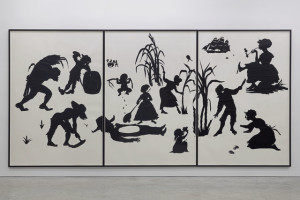This week I’ll be looking at an artist who, like a lot of modern artists, uses photography to create her pieces. But Laurie Simmons’ photos are not in any way average. Her subjects are often strange, and honestly somewhat creepy (she frequently takes pictures of dolls and dummies), creating an unsettling atmosphere. But, above all, her work is extremely compelling and begs the viewer to look closer.
Simmons was born in Long Island in 1949 and later attended the Tyler School of Art in Philadelphia. Growing up, her family sounds pretty conventional– her mom was a housewife and her dad was a dentist. But, the funny thing is that Simmons’ own children and husband are anything but normal. Her husband is Carroll Dunham, a painter, and her daughters are Grace and Lena. Yup, Lena Dunham is her daughter. If anyone has seen the movie “Tiny Furniture,” directed by and starring Lena, you’ve also seen Laurie Simmons, who naturally played the role of her mother. She honestly pretty much just plays herself, as she’s a successful and offbeat photographer in the movie. I just thought it would be interesting to put that little side note in before I really get started talking about Simmons’ work, because I found it awesome that two such influential women just happen to be mother and daughter!
“Tiny Furniture”, 2010
In her pieces, Simmons not only questions the role of women in our society, but that of the everyday American, too. Whether she is photographing dolls, live performers, or household objects, the artist examines the “struggle over identity in an environment in which the value placed on consumption, designer objects, and domestic space is inflated to absurd proportions.” The reason she so frequently uses dolls is because she sees them as almost the epitome of forced female gender roles, and she wants to explore how this may affect women in reality. She once claimed that the reason behind her and other women choosing photography was very deliberate– “I’m not going to say it was a radical act, but we were certainly doing it in some sort of defiance of, or reaction to, a male-dominated world of painting.”
The Love Doll, 2011
Here, Simmons photographs a life-sized doll from Japan. She shows its life over the span of several weeks, doing everyday (and some not so everyday) tasks.
Walking Cake, II
Simmons also has a series of works featuring oversized objects supported by a pair of women’s legs. It is meant to question the way we sometimes pigeonhole women, associating them with certain, “traditionally feminine”, objects. I think this example is a particularly good representation of that idea.
The artist has achieved major success throughout her life, holding many solo exhibitions, receiving awards, and gaining national recognition. I think her work is fascinating, and I can see why it has captured the public’s interest.
The cool thing about modern artists is that you can see how their work is still evolving and what projects they are working on now. If you’re interested, here is a link to her instagram: https://www.instagram.com/lauriesimmons/?hl=en.
Sources:
https://en.wikipedia.org/wiki/Laurie_Simmons#cite_note-3
http://www.pbs.org/art21/artists/laurie-simmons








